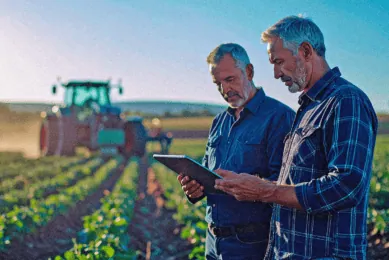AI to help create a smarter post-COVID-19 agriculture

AI is well on its way to helping create a post-COVID-19 agriculture world that’s more efficient, less wasteful, and truly smarter than the one before.
While the world slowly begins to reopen after its initial COVID-19 lockdown, we’re still wrapping our heads around its potential long-lasting effects. One thing that has likely changed forever: how companies work – especially with technology. And the agriculture industry has put itself in a unique position to revolutionise its operations with these new and existing technologies.
Adoption of AI-driven technology quickened by COVID-19
Before the pandemic, the agriculture sector’s adoption of AI-driven technology was already on the rise, and COVID-19 has only quickened its growth. Here at DroneDeploy, we saw a 32% increase in drone flights across the agriculture vertical from 2018-2019. And while the beginning of 2020 was understandably volatile, we actually saw a 33% increase in takeoffs across U.S. agriculture users from mid-March to mid-April – the heart of COVID-19 lockdown.
The rise in agricultural automation will continue to drive industry innovation post-pandemic
Agriculture professionals have been quick to realise that investing in drone data solutions still allows for valuable work like field surveying and seeding to occur remotely, all while keeping workers safely off the job site.
This rise in agricultural automation will continue to drive industry innovation post-pandemic and possibly revolutionise their processes for the better.
Text continues underneath image
Smart Planting
One of the first activities that could evolve is the planting process. Currently, drone software can automatically count plants shortly after they emerge from the ground to gauge if areas need to be re-planted (e.g., DroneDeploy’s Count AI tool can automatically calculate trees). It can also help understand which variety of seed performs the best in different types of soil, locations, climates, etc.
Drone software integrated into equipment management
Drone software is increasingly being integrated into equipment management tools, enabling not just detecting low crop population areas, but also providing the data as input to the planter to re-plant only particular sections.
This automation could also potentially make a recommendation about which variety of seed/crop to plant. Based on the previous 10-20 years of data, agronomists can determine which varieties performed best under predicted climate conditions.
FBN currently offers a similar service through crowd-sourced data, but AI has the power to analyse, predict, and provide such recommendations more smartly and accurately.
Text continues underneath image
Growing re-imagined
Second, the growing season will become more efficient and sustainable. Currently, AI tools can detect nitrogen deficiencies, water issues (e.g., ponding or lack of water), weeds, and specific diseases or pests in surveyed land plots.
Blue River Technology uses AI and a camera on a sprayer to detect and spot-spray weeds. Precise soil moisture sensors and field weather stations can also indicate whether the field moisture level is adequate.
Drone data to help detect field issues
Drone data can help detect these field issues then automatically activate a solution. For example, a drone map could detect a nitrogen deficiency, then inform a sprayer to spray only deficient areas.
In the same vein, a drone solution could spot a lack of water or weed growth and feed the map to an AI, so it only irrigates specific field positions or directs herbicide only on weeds.
Text continues underneath image
Overhauling the harvest
Finally, harvesting practices have the potential to change for the better with the help of AI. The order in which you harvest your fields depends on which ones have “dried down” first.
For example, typically corn needs to be harvested with a moisture level of 24-33% (and a maximum moisture level of 40%). Cornfields that have not yet turned yellow or brown will have to be mechanically dried post-harvest. Drone imagery can help growers gauge which fields have dried down to the optimum levels and can determine which ones to harvest first.
COVID-19 has undoubtedly presented the agriculture sector with several challenges, but it has also enabled many opportunities.
Additionally, AI in combination with variables, modeling, and seed genetics can also predict which fields planted from existing seed varieties will be ready to harvest first. This level of data removes the guesswork from growing and enables growers to harvest more efficiently.
Farming’s future
As automation in agriculture continues to develop, it’s exciting to see what innovation will come out of this season. COVID-19 has undoubtedly presented the agriculture sector with several challenges, but it has also enabled many opportunities.
Bill Gates once said, “We always overestimate the change that will occur in the next two years and underestimate the change that will occur in the next ten.” While the changes we’ve predicted may not happen right away, there are vast possibilities over the next several decades. We’ll see drones and AI utilised in ways that we could never have imagined.
Post-COVID-19 agriculture
For now, though, in 2020, change is already afoot. AI is well on its way to helping create a post-COVID-19 agriculture world that’s more efficient, less wasteful, and truly smarter than the one before.
Join 17,000+ subscribers
Subscribe to our newsletter to stay updated about all the need-to-know content in the agricultural sector, two times a week.



